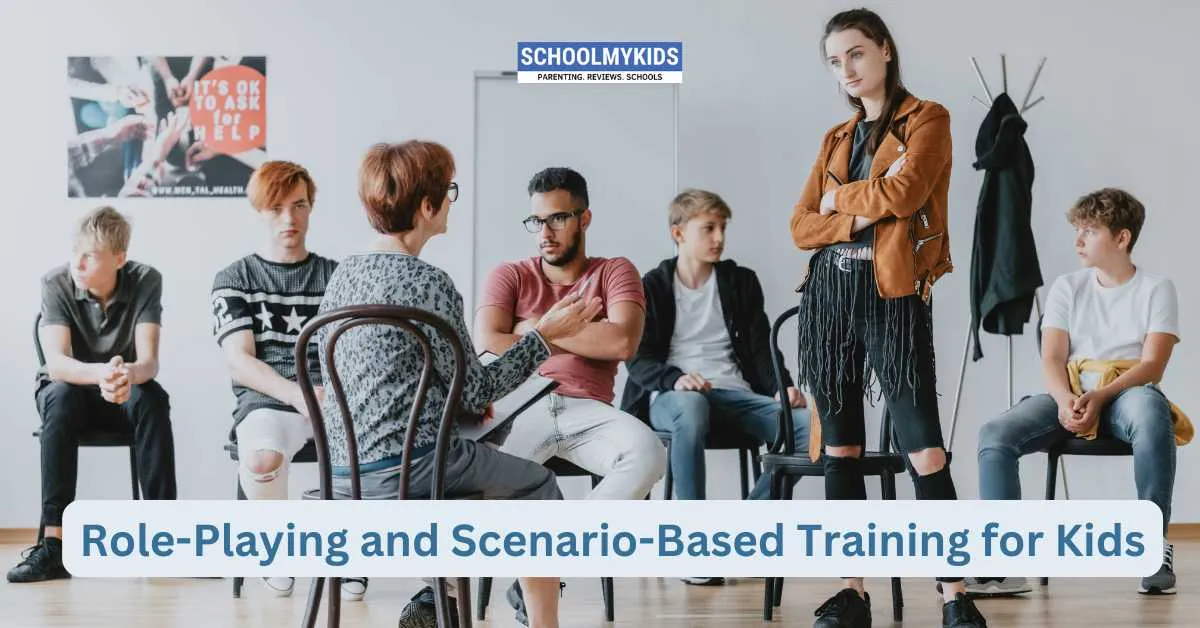Role-playing and scenario-based training are dynamic, interactive methods that empower children to navigate challenging social situations—especially bullying—by practicing effective responses in a safe environment. These techniques help children build essential skills, such as assertive communication, critical thinking, and emotional regulation, while boosting their confidence in handling real-life challenges.
What Is Role-Playing and Scenario-Based Training?
Role-playing involves acting out a situation or dialogue, enabling children to step into different roles. Scenario-based training expands on this by presenting realistic situations that children might encounter, such as bullying, exclusion, or conflicts with peers. By simulating these experiences, children learn to identify the issues, practice effective responses, and reflect on the outcomes in a controlled setting.
Benefits of Role-Playing for Kids
1. Enhancing Communication Skills
Role-playing teaches children to express their feelings and thoughts clearly and confidently. They learn how to:
- Use “I” Statements: For example, “I feel hurt when you say that,” which helps communicate feelings without sounding aggressive.
- Maintain Calm Body Language: Practicing steady eye contact, upright posture, and a calm tone of voice reinforces the message and deters bullies.
- Active Listening: Engaging in role-play encourages kids to listen to others’ perspectives, which can lead to better conflict resolution.
2. Building Confidence and Resilience
When children practice responses in a safe environment, they gain confidence in their ability to handle difficult situations. Over time, this training helps them:
- Feel Prepared: Familiarity with potential scenarios reduces anxiety and helps children feel more equipped to deal with real-life bullying.
- Develop Resilience: By learning that setbacks and conflicts are manageable, children build the mental resilience necessary to bounce back from adversity.
3. Encouraging Problem-Solving and Critical Thinking
Scenario-based training requires children to think on their feet. They learn to:
- Identify the Problem: Recognize bullying behaviors and understand the context of a situation.
- Generate Solutions: Brainstorm multiple ways to respond, from assertive communication to seeking help from a trusted adult.
- Evaluate Outcomes: Reflect on which strategies were effective and why, helping them refine their responses over time.
4. Fostering Empathy and Social Awareness
Role-playing allows children to step into the shoes of both the victim and the bully. This practice:
- Develops Empathy: Understanding how others feel in challenging situations encourages kinder, more compassionate behavior.
- Promotes Inclusivity: Experiencing different perspectives helps children appreciate diversity and build supportive relationships.
Implementing Role-Playing and Scenario-Based Training
1. Create a Safe Environment
Before starting role-play activities, it’s important to establish a safe, supportive space where children feel comfortable expressing themselves without fear of judgment.
- Set Clear Guidelines: Explain the purpose of the exercise and the importance of respectful, constructive feedback.
- Encourage Openness: Let children know that all ideas are welcome and that making mistakes is part of the learning process.
2. Design Realistic Scenarios
Choose scenarios that reflect the types of bullying or social challenges your child might face. Some examples include:
- Verbal Teasing: A scenario where a peer uses hurtful language, prompting your child to practice assertive responses.
- Exclusion from a Group: Role-play a situation where a child is left out of a game or group activity, encouraging strategies to seek help or integrate into the group.
- Cyberbullying: Simulate an online interaction where a friend receives a negative comment, guiding your child through the steps of digital safety and reporting the incident.
3. Role-Play Different Perspectives
Encourage children to switch roles during the exercise:
- Victim Role: Practicing how to respond assertively to bullying.
- Bystander Role: Learning how to support a friend who is being bullied.
- Bully Role (Optional): Understanding the impact of their behavior can sometimes help children who may be at risk of bullying others. However, this should be done sensitively and ideally under the guidance of an experienced facilitator.
4. Use Props and Visual Aids
Incorporate props, costumes, or visual aids to make the role-playing experience more engaging and realistic. For instance, use a phone or tablet for cyberbullying scenarios or create a simple stage area for physical interactions. These tools can make the exercise feel more authentic and help children immerse themselves in the situation.
5. Debrief and Reflect
After each role-play session, hold a debriefing discussion:
- Discuss What Happened: Ask each participant to share their thoughts and feelings about the scenario.
- Evaluate Responses: Talk about which strategies worked well and which might need improvement.
- Highlight Learning Points: Reinforce the key lessons of assertive communication, safe intervention, and the importance of seeking help when needed.
- Encourage Feedback: Allow children to provide feedback to one another in a supportive, constructive manner.
6. Practice Regularly
Repetition is key to building confidence and competence:
- Integrate into Daily Routines: Consider incorporating short role-playing exercises into regular family or classroom activities.
- Vary Scenarios: Introduce new and diverse scenarios over time to address different aspects of bullying and social conflict.
- Monitor Progress: Keep track of your child’s growth in confidence and skill through regular check-ins and discussions.
Involving Educators and Counselors
Role-playing exercises can be even more effective when they are part of a broader anti-bullying program that involves educators and mental health professionals:
- School Programs: Many schools have implemented social-emotional learning (SEL) programs that incorporate role-playing to teach empathy, conflict resolution, and assertiveness.
- Counselor-Led Sessions: School counselors or external therapists can facilitate role-playing sessions, providing expert guidance and ensuring that sensitive topics are handled appropriately.
- Peer Mentoring: Older students who have successfully navigated bullying can serve as mentors in role-playing exercises, offering insights and encouragement to younger children.
Challenges and Considerations
While role-playing and scenario-based training offer many benefits, there are a few challenges to keep in mind:
- Emotional Sensitivity: Some children may find it difficult to engage in role-playing due to shyness or past traumatic experiences. It’s important to proceed slowly and ensure that each child feels safe and supported.
- Cultural Sensitivity: Tailor scenarios to be culturally relevant and sensitive to the diverse backgrounds of children participating in the exercise.
- Facilitator Expertise: The success of role-playing sessions often depends on the facilitator’s ability to guide discussions and manage group dynamics effectively. Parents and educators should seek professional training if needed.
Conclusion
Role-playing and scenario-based training are powerful tools for helping children learn to recognize and respond to bullying. By simulating real-life situations in a controlled, supportive environment, children can practice assertive communication, build empathy, and develop the problem-solving skills necessary to navigate difficult social interactions. With regular practice, thoughtful debriefing, and the involvement of educators and counselors, role-playing can transform passive bystanders into confident upstanders who actively contribute to a safer, more inclusive community. Ultimately, these interactive strategies not only help children manage bullying but also equip them with lifelong skills that promote resilience and positive social behavior.









Be the first one to comment on this story.